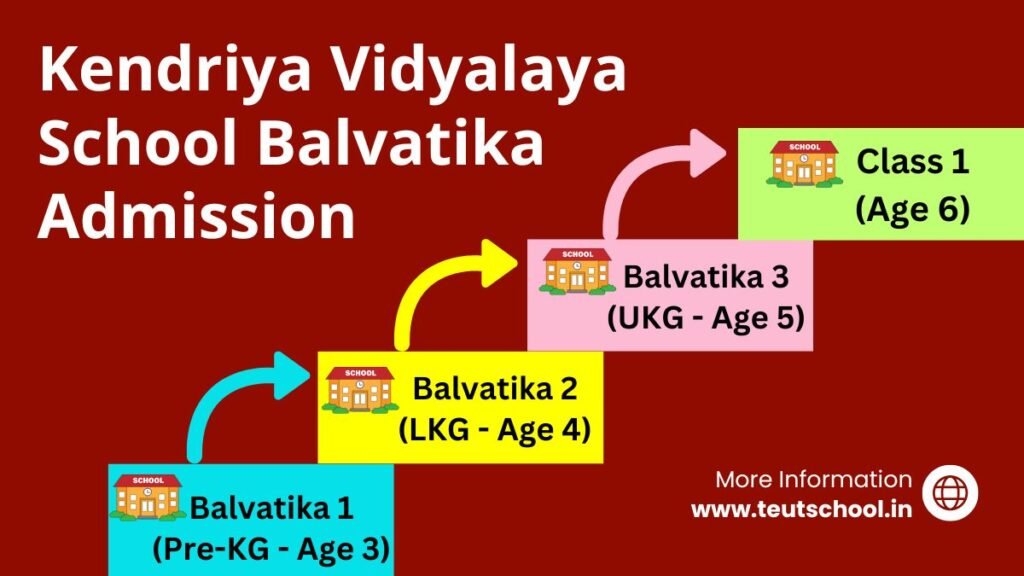KVS Balvatika and Class 1 Admission for 2025-26 Will Be Started on 28th February 2025!

KVS Balvatika and Class 1 Admission 2025-26: The central office of Kendriya Vidyalaya Sangathan (KVS), a renowned educational organization in India, is anticipated to announce the admission schedule and guidelines on February 28, 2025.
Kendriya Vidyalaya Admission 2025-26 Important Dates
| Event | Date |
| KVS Admission Announcement on | 28 February 2025 |
| Online Registration Starts On | 1 March 2025 |
| Online Registration Ends On | 20 March 2025 |
| Application Form Verification Correction | 1 to 20 March 2025 |
| Candidates Check Name in Lottery Draw | 27 March 2025 |
| Draw of Lots (Lottery Selection) | 28 March 2025 |
| Lottery Result Declared On | 29 March 2025 |
| 1st Admission List | 29 March 2025 |
| Waiting List | 29 March 2025 |
Balvatika1, 2, 3 and Class-1 Admission Lottery Results 2025-26
The results of the Balvatika Admission Lottery for the academic year 2025-26 will be announced following the completion of the registration process for Class 1 and the offline admission procedures for Balvatika. Each Kendriya Vidyalaya will establish a committee comprising 5 members to oversee the lottery draw process. In cases where deemed necessary, the Principal may appoint a 6th member from students in classes IX to XII. The lottery draw event will be broadcasted live on YouTube, enabling parents to observe the proceedings remotely. Subsequently, the initial list of admitted students will be displayed on the school’s Notice Board and published on the official website.
| KVS Region | Link |
| KVS Agra 2025-26 Admission Lottery Result | View |
| KVS Ahmedabad 2025-26 Admission Lottery Result | View |
| KVS Bangalore 2025-26 Admission Lottery Result | View |
| KVS Bhopal 2025-26 Admission Lottery Result | View |
| KVS Bhubaneshwar 2025-26 Admission Lottery Result | View |
| KVS Chandigarh 2025-26 Admission Lottery Result | View |
| KVS Chennai 2025-26 Admission Lottery Result | View |
| KVS Dehradun 2025-26 Admission Lottery Result | View |
| KVS Delhi 2025-26 Admission Lottery Result | View |
| KVS Ernakulam 2025-26 Admission Lottery Result | View |
| KVS Gurugram 2025-26 Admission Lottery Result | View |
| KVS Guwahati 2025-26 Admission Lottery Result | View |
| KVS Hyderabad 2025-26 Admission Lottery Result | View |
| KVS Jabalpur 2025-26 Admission Lottery Result | View |
| KVS Jaipur 2025-26 Admission Lottery Result | View |
| KVS Jammu 2025-26 Admission Lottery Result | View |
| KVS Kolkata 2025-26 Admission Lottery Result | View |
| KVS Lucknow 2025-26 Admission Lottery Result | View |
| KVS Mumbai 2025-26 Admission Lottery Result | View |
| KVS Patna 2025-26 Admission Lottery Result | View |
| KVS Raipur 2025-26 Admission Lottery Result | View |
| KVS Ranchi 2025-26 Admission Lottery Result | View |
| KVS Silchar 2025-26 Admission Lottery Result | View |
| KVS Tinsukia 2025-26 Admission Lottery Result | View |
| KVS Varanasi 2025-26 Admission Lottery Result | View |
KVS Class-1 Age Eligibility Online Calculator
You may verify your child’s eligibility using our exclusive online tool at no cost. Simply input your child’s date of birth into the tool, and it will determine whether your child qualifies for admission to class 1 in the current academic year. Additionally, the tool will indicate the year in which your child will be eligible for class 1 admission in KVS.
Click to Check Eligibility in KVS Admission 2025-26
Kendriya Vidyalay New Admission Guidelines 2025-26
The Kednriya Vidyalaya Sangathan (KVS) will be issued a new admission gudilines for the current year 2025-26 soon! The comprehensive admission information is provided in the PDF document, which is divided into three sections: Part A outlines General Guidelines, Part B details Special Provisions, and Part C describes Admission Procedures. Part A contains extensive information regarding Admission Priorities, an Age Eligibility table, class capacity, reservation policies, and procedures for transfer cases.
The admission of children into Kendriya Vidyalayas will be based on transfer certificates issued by schools adhering to the NCERT/CBSE curriculum and operated by Armed Forces (Army, Air Force, Navy) and Para Military Forces, including CRPF, BSF, ITBP, SSB, CISF, NSG, Assam Rifles, as well as schools managed by the Indian Coast Guard, ISRO, AEES (Atomic Energy Education Society), and DRDO. Such admissions will only be considered if the enrollment is below 40 for Class I and 45 for all other classes, provided that the parent has been transferred to that location, intends to settle there post-retirement, or has been assigned to a non-family station or a Naxal-affected area while choosing to keep the family in a different location. Additionally, these requests will be evaluated only in areas where schools operated by these organizations are not present.
Fresh KVS Admission in Class X and XII 2025-26
New admissions for Class X and XII for the academic year 2025-26: New admissions for Class X and XII, excluding students from Kendriya Vidyalayas (KVs), will be considered based on the availability of seats. The Principal of the KV will evaluate such admissions for Class X and XII only if the average class strength is below 32. The following conditions must also be met:
(i) The student must have been enrolled in a similar course of study at a CBSE-affiliated institution.
(ii) For Class X, the student is required to have achieved a minimum of 55% aggregate marks in Class IX.
(iii) For Class XII admission, a minimum of 55% marks in the Class XI examination is essential.
(iv) The student must meet the eligibility criteria as outlined in the KVS Admission Guidelines.
The subject combinations available to students can be found in Kendriya Vidyalayas.
(vi) Fresh admissions will be prioritized for categories 1 and 2 for Civil and Defence sector KVs, and categories 1 to 3 for IHL/Project sector KVs only.
KVS Admission 2025-26 Selection Process for Class 1
- Step-1: Registration
- Step-2: Final Panel List
- Step-3: Lottery Draw
- Step-4: Admission List
For the upcoming admissions, 25% of the available seats will be allocated for the Right to Education (RTE). Additionally, 15% of the seats will be reserved for Scheduled Castes (SC), 7.5% for Scheduled Tribes (ST), and 27% for Other Backward Classes – Non Creamy Layer (OBC-NCL).
The admission process will commence with the allocation of seats under the RTE Act, followed by the admission of Children with Special Needs (CwSN). Subsequently, candidates from Category 1 (Cat-1) will be considered, which will also encompass SC, ST, and OBC-NCL students. Following the completion of Cat-1 admissions, the process will proceed to Category 2 (Cat-2), which will similarly include SC, ST, and OBC-NCL candidates, extending up to Category 3 in the case of Project/IHL Schools.
Any shortfall in the reserved seats for SC, ST, and OBC-NCL will be assessed after accounting for the number of SC, ST, and OBC-NCL children admitted under the RTE quota and the priority categories of Cat-1 and Cat-2.
The reservation criteria will be applied within the approved class strength of 32 students per section, as follows:
- RTE: 25% (8 seats)
- SC: 15% (5 seats)
- ST: 7.5% (2 seats)
- OBC: 27% (8 seats)
- Additionally, 3% of seats will be reserved horizontally for CwSN applicants.
Upon the conclusion of the registration process, the lottery sequence for each Kendriya Vidyalaya will be conducted in the following order:
a) RTE Lottery
b) All CwSN Lotteries
c) CAT-I
d) CAT-II
e) SC
f) ST
g) OBC
h) CAT-III
i) CAT-IV
j) CAT-V
k) CAT-VI (if applicable).
Distance Criteria for KVS Admission 2025-26
Kendriya Vidyalayas are situated in regions with varying population densities, leading to their classification for the purpose of defining neighborhood limits as follows:
- Major cities and urban areas (including all district headquarters and metropolitan regions) have a radius of 5 km.
- All other locations not included in the first category have a radius of 8 km.
Please note the following:
- All applicants must provide proof of residence.
- A written self-declaration from the parent regarding the distance may also be accepted, pending verification. Admissions for Class I will be conducted online, while admissions for other classes will occur offline, based on the availability of vacancies.
